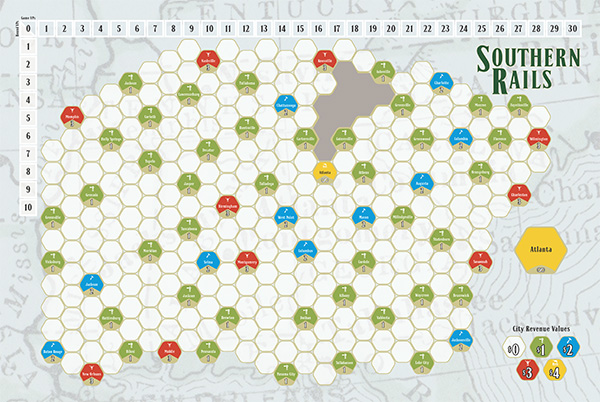Buy Stocks and Build Capital in Southern Rails

Become a railway tycoon in this 3-5 player game from designer John Bohrer that allows train game beginners to learn the basics of the genre.
Gameplay
Southern Rails makes the train game genre accessible with easy-to-learn rules and quick gameplay. The object of the game is to build up each of the six railways available, increasing their stock prices in the process, and cashing in on their growing dividends in the form of points.
The board simply depicts the southeastern United States in hexagonal form. Cities will be in one of the four colors (red, blue, green, and yellow). These differently-colored cities will not only dictate the number of different rail companies that can be built in those locations, but will also provide a dollar value that will help to increase the stock prices of each railway that is able to occupy the city. However, the board is largely made up of blank white spaces where much of the game’s action and strategy takes place as players begin to build out each company’s rail infrastructure.
At the start of the game, players will begin by selecting a first player. The first player will select a stock (all of equal value) from one of the six represented railway companies. Selection of stock will continue clockwise until each player has one stock and two remain unclaimed. The row of initial stocks will be replenished save for the leftover stocks, then a second draft where players must choose a different company will happen in reverse order until the first player grabs their second stock.
Using their acquired stocks and starting with the first player, players will then lay out cubes to form the railways for their companies. Players begin by placing the first cube of the companies in any city they choose. As play continues, subsequent cubes from the same railroad company must be placed on an adjacent hexagon. If a cube is placed in a city, the player who placed it will move the disc(s) of the company’s color along two tracks: the track that shows which town color the cube was placed, as well as the Revenue track, which represents how much that company’s stock price is now worth. There is a limit to the number of cubes allowed on each space, as dictated by its color. Atlanta, the only yellow hex, allows for one of every company’s cube to be placed on it. Red hexes allow three different companies, blue and white hexes allow two (though white hexes offer no gain in revenue or city track progress), and green towns allow only one cube.
Cubes are placed until one company has 10 of its cubes on the board. At this point, the first scoring phase occurs. Each track will offer one victory point per share for the company that has the highest value on that track. However, if multiple companies are tied for the highest value on a track, then no victory points are awarded. The city tracks (green, blue, and red) offer 1 victory point per owned stock. The revenue track will offer 2 victory points per owned stock. There are two other opportunities to own points: the company with the most track laid out onto the board earns 1 victory point per share (with a minimum of 11, so this will not be available in the first scoring phase), and the company with the least amount of claimed stock will award 1 victory point per share owned by a player. Points are kept on the round tracker and this will determine the player order ahead of the next round. The player with the fewest points becomes the first player for the next round. Points are then transferred to the game points tracker where cumulative points over the course of the game are tracked. One stock of each company will be laid out again, and starting with the designated first player, players will choose one of the available stocks until all players have claimed one. At this point, players are able to claim stocks that match ones they already own. Play continues until another company lays out 10 cubes and points are scored for the round again, with one more stock chosen by players. After 4 companies have had 10 cubes placed onto the board, scoring happens once more and the player with the most victory points is the winner.

Review
Southern Rails offers a simple, nearly intuitive gameplay that makes learning about the mechanics of more complex train games easy. It involves stock manipulation, railway building, and easy-to-follow tracks so everyone can see how each company is progressing. Likewise, it maintains the easy transitions between being a cooperative game (where multiple players may own stock in the same company and therefore focus on that stock to build up its rails quickly) and competitive (players wanting to find good success across its whole stock portfolio to maximize their points each round).
The design may be a bit simplistic and lack pizzazz, but the ability to easily differentiate the cities and see the many paths available to build rails is welcome. Knowing where different companies may be headed and what cities they may occupy (and potentially lock out any other rail companies from being able to build in those cities) is key to finding success in the game.
The gripes about the game are few. Again, people lured in by beautiful art and graphic design may find Southern Rails too scaled down. Likewise, the minimum player count will be a put off to people who are looking for entry level train games that also include the 1-2 player counts.
However, anyone who is interested in getting into the train game genre — or are hoping to make converts — will be happy to play Southern Rails. The game plays quickly, as most 3-4 player games are over in 45 minutes (including the teach) because the mechanics and gameplay are easy to pick up and play almost immediately.
Pros: Great entry point into the train game genre, easy to learn gameplay
Cons: Minimalism in the art and graphic design






